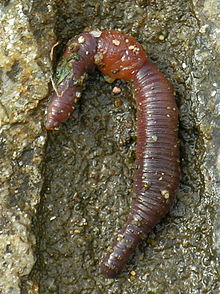- Metamerism (biology)
-
In biology, metamerism is a linear series of body segments fundamentally similar in structure, though not all such structures are entirely alike in any single life form because some of them perform special functions.[1] In animals, metameric segments are referred to as somites or metameres. In plants, they are referred to as metamers or, more concretely, phytomers.
Contents
In animals
In animals, metamery is defined as a mesodermal event resulting in serial repetition of unit subdivisions of ectoderm and mesoderm products[1]. Endoderm is not involved in metamery. Segmentation is not the same concept as metamerism. Segmentation can be confined only to ectodermally derived tissue, e.g., in the Cestoda tapeworms. Metamerism is far more important biologically since it results in metameres, also called somites, that play a critical role in advanced locomotion.
Metamerism can be divided into two main categories:
- homonomous metamery is a strict serial succession of metameres, of which, in fact, there are no true examples in the invertebrates; however, the Annelida worms, e.g., nereis, are used as a model to portray homonomous metamery.
- heteronomous metamery is the condition where metameres have grouped together to perform similar tasks. The extreme example of this is the insect head (5 metameres), thorax, and abdomen, where the segments are only as regards structures not crucial to specific segment function (e.g. ladder nerve system or somites).
Humans and most other chordates have similar groupings of metameres. Here however, the metameres of each group are essentially fused into one and few repetitive features are seen. Some vestiges – e.g. branchial arches – are still discernible. The process that results in the grouping of metameres is called "tagmitization", and each grouping is called a tagma (plural: tagmata).
In plants
A metamer is one of several segments that share in the construction of a shoot, or into which a shoot may be conceptually (at least) resolved. [2] In the metameristic model, a plant consists of a series of 'phytons' or phytomers, each consisting of an internode and its upper node with the attached leaf. As Asa Gray (1850) wrote:[3]
The branch, or simple stem itself, is manifestly an assemblage of similar parts, placed one above another in a continuous series, developed one from another in successive generations. Each one of these joints of stem, bearing its leaf at the apex, is a plant element; or as we term it a phyton,—a potential plant, having all the organs of vegetation, namely, stem, leaf, and in its downward development even a root, or its equivalent. This view of the composition of the plant, though by no means a new one, has not been duly appreciated. I deem it essential to a correct philosophical understanding of the plant.
Some plants, particularly grasses, demonstrate a rather clear metameric construction, but many others either lack discrete modules or their presence is more arguable.[2] Phyton theory has been criticized as an over-ingenious, academic conception which bears little relation to reality. [4] Eames (1961) concluded that "concepts of the shoot as consisting of a series of structural units have been obscured by the dominance of the stem- and leaf-theory. Anatomical units like these do not exist: the shoot is the basic unit."[5] Even so, others still consider comparative study along the length of the metameric organism to be a fundamental aspect of plant morphology.[6]
Metameric conceptions generally segment the vegetative axis into repeating units along its length, but constructs based on other divisions are possible. [2] The pipe model theory conceives of the plant (especially trees) as made up of unit pipes ('metamers'), each supporting a unit amount of photosynthetic tissue.[7] Vertical metamers are also suggested in some desert shrubs in which the stem is modified into isolated strips of xylem, each having continuity from root to shoot.[2] This may enable the plant to abscise a large part of its shoot system in response to drought, without damaging the remaining part.
In vascular plants, the shoot system differs fundamentally from the root system in that the former shows a metameric construction (repeated units of organs; stem, leaf, and inflorescence), while the latter does not. The plant embryo represents the first metamer of the shoot in spermatophytes or seed plants.
Plants (especially trees) are considered to have a 'modular construction,' a module being an axis in which the entire sequence of aerial differentiation is carried out from the initiation of the meristem to the onset of sexuality (e.g flower or cone development) which completes its development.[2] These modules are considered to be developmental units, not necessarily structural.
See also
- Metamerism (for other meanings)
- Segmentation
- Phytomer
References
- ^ a b Shull, Franklin; George Roger Larue, Alexander Grant Ruthven (1920). Principles of Animal Biology. McGraw-Hill book company. pp. 108. http://books.google.com/books?id=PMOs9gri1CsC&pg=PA108.
- ^ a b c d e White, J. 1979. The plant as a metapopulation. Annual Review of Ecology and Systematics 10:109-145.
- ^ Gray, A. 1850. On the composition of the plant by phytons, and some applications of phyllotaxis. Proceedings of the American Association for the Advancement of Science 2:438-444.
- ^ Arber, A. 1930. Root and shoot in the angiosperms: a study of morphological categories. New Phytologist 29(5):297-315.
- ^ Eames, A.J. 1961. Morphology of the Angiosperms. McGraw-Hill, New York.
- ^ Kaplan, D.R. 2001. The science of plant morphology: Definition, history, and role in modern biology. American Journal of Botany 88(10):1711-1741.
- ^ Shinozaki, I., Yoda, K. Hozumi, K., and Kira, T. 1964. A quantitative analysis of plant form —the pipe model theory. I. basic analyses. Japanese Journal of Ecology 14:97-105.
Developmental biology Embryology Embryogenesis (Human embryogenesis · Drosophila embryogenesis · Fish embryogenesis) · Polarity in embryogenesisOther Categories:- Developmental biology
- Biology articles needing attention
- Zoology
Wikimedia Foundation. 2010.

